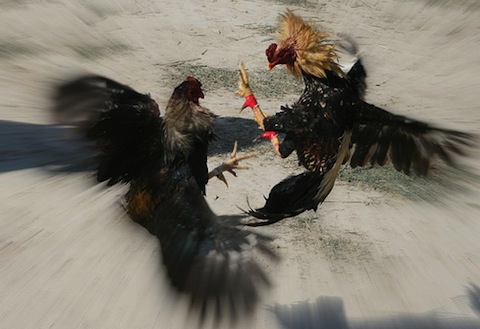
Though my gambling amounts to little more than the occasional hand of $5 blackjack while in Vegas, I’m fascinated by the work of oddsmaking. It takes a special kind of genius to create a system in which the house will always win in the long run, though by just enough to preserve the game’s entertainment value. Adding to the challenge is that constant interference of players who constantly probe these systems for weaknesses—if you’re not careful enough when writing the house rules, a bunch of math whizzes from Miami are bound to take you to the cleaners.
But there needn’t be a wizard behind the curtain in order to develop “perfect” betting systems. This has happened organically for centuries, presumably through years’ worth of trial and error. That’s the lesson I took away from reading Clifford Geertz’s Deep Play: Notes on the Balinese Cockfight, a true classic of anthropology. In attempting to describe how this bloody “sport” reinforces Bali’s strict social hierarchy, Geertz describes the various types of wagers that are placed on cockfights. These basically break down into two categories: “center” bets, which are between the bird owners and are governed by official rules, and side bets between spectators, which are completely unregulated. Geertz found that despite this wagering chaos, the center and side bets worked in tandem to create the sort of system that Vegas casinos consider ideal:
The higher the center bet, the more likely the match will in actual fact be an even one. In a large-bet fight the pressure to make the match a genuinely fifty-fifty proposition is enormous, and is consciously felt as such. For medium fights the pressure is somewhat less, and for small ones less yet, though there is always an effort to make things at least approximately equal, for even at fifteen ringgits (five days work) no one wants to make an even money bet in a clearly unfavorable situation. And, again, what statistics I have tend to bear this out. In my fifty-seven matches, the favorite won thirty-three times over-all, the underdog twenty-four, a 1.4 to 1 ratio. But if one splits the figures at sixty ringgits center bets, the ratios turn out to be 1.1 to 1 (twelve favorites, eleven underdogs) for those above this line, and 1.6 to 1 (twenty-one and thirteen) for those below it. Or, if you take the extremes, for very large fights, those with center bets over a hundred ringgits the ratio is 1 to 1 (seven and seven); for very small fights, those under forty ringgits, it is 1.9 to 1 (nineteen and ten).
The paradox of fair coin in the middle, biased coin on the outside is thus a merely apparent one. The two betting systems, though formally incongruent, are not really contradictory to one another, but part of a single larger system in which the center bet is, so to speak, the “center of gravity,” drawing, the larger it is the more so, the outside bets toward the short-odds end of the scale. The center bet thus “makes the game,” or perhaps better, defines it.
Somewhere up there, Charles K. McNeil is smiling at the genius of Balinese bookmakers. Though maybe not if he was into animal rights.
(Image via Tariq Sulemani)


Balinese cockfighting | Allaboutlovepo // Apr 2, 2012 at 8:53 am
[…] A Perfect System, Soaked in Blood | Microkhan by Brendan I. Koerner […]